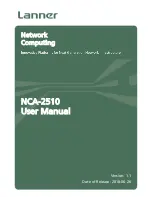
Appendix D. The OSI Framework
Overview
The Open Systems Interconnection Model defines a framework for inter-computer communications.
It categorizes different protocols for a great variety of network applications into seven smaller, more
manageable layers. The model describes how data from an application in one computer can be
transferred through a network medium to an application on another computer.
Control of data traffic is passed from one layer to the next, starting at the application layer in one
computer, proceeding to the bottom layer, traversing over the medium to another computer and then
delivering up to the top of the hierarchy. Each layer handles a certain set of protocols, so that the
tasks for achieving an application can be distributed to different layers and be implemented
independently. The model is relevant to understanding the operation of many NetDefendOS features
such as ARP, Services and ALGs.
Layer number
Layer purpose
Layer 7
Application
Layer 6
Presentation
Layer 5
Session
Layer 4
Transport
Layer 3
Network
Layer 2
Data-Link
Layer 1
Physical
Figure D.1. The 7 Layers of the OSI Model
Layer Functions
The different layers perform the following functions:
Layer 7 - Application Layer
Defines the user interface that supports applications directly.
Protocols: HTTP, FTP, TFTP. DNS, SMTP, Telnet, SNMP
and similar. The ALGs operate at this level.
Layer 6 - Presentation Layer
Translates the various applications to uniform network
formats that the rest of the layers can understand.
Layer 5 - Session Layer
Establishes, maintains and terminates sessions across the
network. Protocols: NetBIOS, RPC and similar.
Layer 4 - Transport Layer
Controls data flow and provides error-handling. Protocols:
TCP, UDP and similar.
Layer 3 - Network Layer
Performs addressing and routing. Protocols: IP, OSPF, ICMP,
IGMP and similar.
Layer 2 - Data-Link Layer
Creates frames of data for transmission over the physical
layer and includes error checking/correction. Protocols:
Ethernet, PPP and similar. ARP operates at this level.
Layer 1 - Physical Layer
Defines the physical hardware connection.
544
Summary of Contents for NetDefend DFL-260E
Page 27: ...1 3 NetDefendOS State Engine Packet Flow Chapter 1 NetDefendOS Overview 27...
Page 79: ...2 7 3 Restore to Factory Defaults Chapter 2 Management and Maintenance 79...
Page 146: ...3 9 DNS Chapter 3 Fundamentals 146...
Page 227: ...4 7 5 Advanced Settings for Transparent Mode Chapter 4 Routing 227...
Page 241: ...5 4 IP Pools Chapter 5 DHCP Services 241...
Page 339: ...6 7 Blacklisting Hosts and Networks Chapter 6 Security Mechanisms 339...
Page 360: ...7 4 7 SAT and FwdFast Rules Chapter 7 Address Translation 360...
Page 382: ...8 3 Customizing HTML Pages Chapter 8 User Authentication 382...
Page 386: ...The TLS ALG 9 1 5 The TLS Alternative for VPN Chapter 9 VPN 386...
Page 439: ...Figure 9 3 PPTP Client Usage 9 5 4 PPTP L2TP Clients Chapter 9 VPN 439...
Page 450: ...9 7 6 Specific Symptoms Chapter 9 VPN 450...
Page 488: ...10 4 6 Setting Up SLB_SAT Rules Chapter 10 Traffic Management 488...
Page 503: ...11 6 HA Advanced Settings Chapter 11 High Availability 503...
Page 510: ...12 3 5 Limitations Chapter 12 ZoneDefense 510...
Page 533: ...13 9 Miscellaneous Settings Chapter 13 Advanced Settings 533...






























